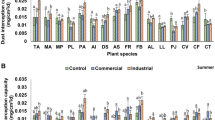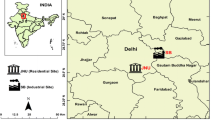Abstract
Bio monitoring studies are extremely relevant in the field of air pollution science in relation to urban ecosystem restoration. The present study was designed in order to assess the dust capturing efficiency and air pollution tolerance index (APTI) of 12 selected tree species growing along the road side at control and polluted site of Aizawl, Mizoram, northeast India. Highest dust deposition was found in Ficus benghalensis (1.02 mg cm−2) and lowest in Bauhinia variegate (0.54 mg cm−2) at polluted site. APTI of 12 plant species were evaluated by analyzing four important biochemical parameters such as ascorbic acid content, relative water content, leaf extract pH and total leaf chlorophyll. High values of APTI were recorded in F. benghalensis (19.48) and least for Artocarpus heterophyllus (8.11) at control site. The anticipated performance index (API) was calculated for different species by combining the resultant APTI values with some relevant biological and socioeconomic characters. According to API, F. bengalensis, Mangifera indica, Psidium guajava, Ficus religiosa, Artocarpus heterophyllus and Lagerstroemia speciosa were evaluated as the best suited variety for plantation along the roadside of the polluted area.






Similar content being viewed by others
References
Agarwal M, Singh SK, Singh J, Rao DN (1991) Biomonitoring of air pollution around urban and industrial sites. J Environ Biol 12:2–11
Anthony P (2001) Dust from walking tracks, impact on rainforest leaves on epiphylls. Cooperative Research Centre for Tropical Rainforest Ecology and Management, Australia
Arnon DI (1949) Coenzyme in isolated chloroplast. Polyphenol oxidase in Beta vulgaris. Plant Physiol 24:1–15
Beg MU, Farooq MH, Bhargava SK, Kidwai MM, Lal MM (1990) Performance of trees around a thermal power station. Environ Ecol 8:791–797
Chaphekar SB (1972) Effects of atmospheric pollutants on plants in Bombay. J Biol Sci 15:1–6
Chauhan A (2010) Photosynthetic pigment changes in some selected trees induced by automobile exhaust in Dehradun. J N Y Sci 3(2):45–51
Conklin P (2001) Recent advances in the role and biosynthesis of ascorbic acid in plants. Plant Cell Environ 24:383–394
CPCB (1994) National ambient air quality standards. Central Pollution Control Board, Gazette Notification, New Delhi
Das S, Prasad P (2010) Seasonal variation in air pollution tolerance indices and selection of plant species for industrial areas of Rourkela. Ind J Environ Prot 30(12):978–988
Dwivedi AK, Tripathi BD (2007) Pollution tolerance and distribution pattern of plants in surrounding area of coal fired industries. J Environ Biol 28(2):257–263
Escobedo FJ, Wagner JE, Nowak DJ (2008) Analyzing the cost effectiveness of Santiago Chile’s policy of using urban forest to improve air quality. J Environ Manag 86:148–291
Flower MD, Fiscus EL, Burkey KO (2007) Photosynthesis, chlorophyll fluorescence and yield of snap bean (Phaseolus vulgaris L) genotype differing in sensitivity to ozone. Environ Exp Bot 61:190–198
Hoque MA, Banu MNA, Okum E (2007) Exogenous proline and glycinebetaine increase NaCl-induced ascorbate-glutathione cycle enzymes activities and proline improves salt tolerance more than glycinebetaine in tobacco bright yellow-2 suspension-cultured cells. J Plant Physiol 164:1457–1468
Horaginamani SM, Ravichandran M (2010) Ambient air quality in an urban area and its effects on plants and human beings: a case study of Tiruchirappalli, India. Kathmandu Univ J Sci Eng Technol 6:13–19
Jones HG (1994) Plants and microclimate. 2nd Ed. Cambridge University
Joshi N, Bora M (2011) Impact of air quality on physiological attributes of certain plants. Rep Opin 3(2):42–47
Joshi PC, Swami A (2007) Physiological responses of some tree species under roadside automobile pollution stress around city of Haridwar, India. Environmentalist 27:365–374
Joshi PC, Swami A (2009) Air pollution induced changes in the photosynthetic pigment of selected plant species. J Environ Boil 30(2):295–298
Jyothi JS, Jaya DS (2010) Evaluation of air pollution tolerance index of selected plant species along roadsides in Thiruvananthapuram, Kerala. J Environ Biol 31(3):379–386
Keller T, Schwager H (1977) Air pollution and ascorbic acid. Eur J For Pathol 7:338–350
Klumpp G, Furlan CM, Domingos M, Klumpp A (2000) Response of stress indicators and growth parameters of Tibouchina pulchra logn. Exposed to air and soil pollution near the industrial complex of Cubatao, Brazil. Sci Total Environ 246:79–91
Kuddus M, Kumari R, Ramteke WP (2011) Studies on air pollution tolerance of selected plants in Allahabad city, India. J Environ Res Manag 2(3):42–46
Lakshmi PS, Sarawanti KL, Sirinivas N (2009) Air pollution tolerance index of various plant species growing in industrial area. J Environ Sci 2(2):203–206
Laltlanchhuanga SK (2006) Studies of the impact of disturbance on secondary productivity of forest ecosystem with special reference to surface, sub-surface litter insect and other non insect groups M.Sc.dissertation. Mizoram University
Lima JS, Fernandes EB, Fawcett WN (2000) Mangifera indica and Phaseolus vulgaris in the bioindicator of air pollution in Bahia, Brazil. Ecotoxicol Environ Saf 46(3):275–278
Liu YJ, Ding H (2008) Variation in air pollution tolerance index of plants near a steel factory. Trans Environ Dev 4:1790–5079
Margeson JH (1977) Evaluation of the sodium arsenite method for measurement of NO2 in ambient air. J Air Pollut Control Assoc 27:553–556
Mondal D, Gupta S, Dutta JK (2011) Anticipated performance index of some tree species considered for green belt development in an urban area. Int Res J Plant Sci 2(4):99–106
Pandey J, Agrawal M (1994) Evaluation of air pollution phytotoxicity in a seasonally dry tropical urban environment using three woody perennials. New Phytol 126:53–61
Prajapati SK, Tripathi BD (2008) Seasonal Variation of leaf dust accumulation and pigment content in plant species exposed to urban particulates pollution. J Environ Qual 37:865–870
Puckett KJ, Nieboer E, Flora WP, Richardson DHS (1973) Sulphur dioxide: its effect on photosynthetic 14C fixation in lichens and suggested mechanism of phytotoxicity. New Phytol 72:141–154
Rai PK (2009) Comparative assessment of soil properties after bamboo flowering and death in a tropical forest of Indo-Burma hot spot. Ambio J Hum Environ 38(2):118–120
Rai PK (2011a) Dust deposition capacity of certain roadside plants in Aizawl, Mizoram: Implications for environmental geomagnetic studies. In: Recent Advances in Civil Engineering S.B. Dwivedi et al. (Eds) pp 66–73
Rai PK (2011b) Biomonitoring of particulates through magnetic properties of road-side plant leaves. In: Tiwari D (ed) Advances in Environmental Chemistry. Excel India Publishers, New Delhi, pp 34–37
Rai PK (2013) Environmental magnetic studies of particulates with special reference to biomagnetic monitoring using roadside plant leaves. Atmos Environ 72:113–129
Rao DN (1979) Plants as a pollution monitoring device. Fertil News 24:25–28
Rao DN, Leblanc F (1966) Effects of SO2 on the lichens and alga with special reference to chlorophyll. Bryologist 69:69–75
Rao MN, Rao HNV (1989) Air pollution. Tata McGraw Hill Publishing Company Limited, New Delhi
Rao MN, Rao HNV (1998) Air pollution. Tata McGraw Hill Publishing Company Limited, New Delhi
Raza SN, Vijaykumari N, Murthy MS (1985) Air pollution tolerance index of certain plants of Hyderabad. In: Symp Biomonitoring State of Environment. Indian National Science Academy, New Delhi, pp 243–245
Scholz F, Reck S (1977) Effects of acid on forest trees as measured by titration in vitro inheritance in buffering capacity in Picea abies. Water Air Soil Pollut 8:41–45
Sen DN, Bhandari MC (1978) Ecological and water relation to two Citrullus spp. In: Althawadi, A.M. (Ed.). Indian Arid Zone. Environ Physiol Ecol Plants pp 203–228
Seyyednejad SM, Niknejad M, Koochak H (2011) A review of some different effects of air pollution on plants. Res J Environ Sci 5(4):302–309
Sharma AP, Tripathi BD (2009) Biochemical response in tree foliage exposed to coal-fired power plant emission in seasonally dry tropical environment. Environ Monit Assess 158:197–212
Singh SK, Rao DN (1983) Evaluation of the plants for their tolerance to air pollution Proc. Symp on Air Pollution control held at IIT, Delhi pp 218–224
Singh SN, Verma (2007) Phytoremediation of Air Pollutants, A review, In, Environmental Bioremediation Technology, Singh, S.N. and R.D. Tripathi (Eds.), Springer, Berlin Heidelberg 1: 293–314
Swami A, Bhatt D, Joshi PC (2004) Effects of automobile pollution on sal (Shorea robusta) and rohini (Mallotus phillipinensis) at Asarori, Dehradun. Himal J Environ Zool 18(1):57–61
Thambavani S, Sabitha MA (2011) Variation in air pollution tolerance index and anticipated performance index of plants near a sugar factory: implications for landscape-plant species selection for industrial areas. J Res Biol 7:494–502
Tripathi AK, Gautam M (2006) Biochemical parameters of plant an indicator of air pollution. J Environ Biol 28(1):127–132
West PW, Gaeke GC (1956) Fixation of sulphur dioxide as sufitomercurate III and subsequent colorimetric determination. Anal Chem 28:1816
Wolfenden J, Wookey PA, Lucas PW, Mansfield TA (1992) Action of pollutants individually and in combination. In: Barker JR, Tingy DT (eds) Air pollution effect on biodiversity. Vannostrand Reinhold, New York, pp 72–91
Woo SY, Je SM (2006) Photosynthetic rates and antioxidant enzyme activity of Platanus occidentalis growing under two levels of air pollution along the streets of Seoul. J Plant Biol 49:315–319
Acknowledgments
PKR wishes to acknowledge the Department of Biotechnology (DBT) vide research and the Department of Science and Technology (DST) for providing financial assistance in the form of research project (vide project no. BT/PR-11889/BCE/08/730/2009 and SR/FTP/ES-83/2009, respectively). Thanks are due to Dr. Onkar Nath Tiwari, Dr. Diwakar Tiwari and Dr. Umesh Sharma for their useful discussion and cooperation in this work. We also wish to acknowledge and thank Professor Lalthantluanga, Vice Chancellor, Mizoram University, for his kind inspiration to accomplish the present work.
Author information
Authors and Affiliations
Corresponding author
Rights and permissions
About this article
Cite this article
Rai, P.K., Panda, L.L.S. Dust capturing potential and air pollution tolerance index (APTI) of some road side tree vegetation in Aizawl, Mizoram, India: an Indo-Burma hot spot region. Air Qual Atmos Health 7, 93–101 (2014). https://doi.org/10.1007/s11869-013-0217-8
Received:
Accepted:
Published:
Issue Date:
DOI: https://doi.org/10.1007/s11869-013-0217-8




